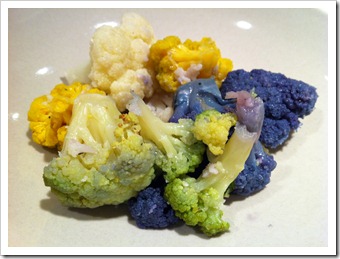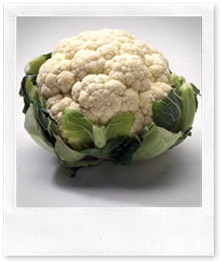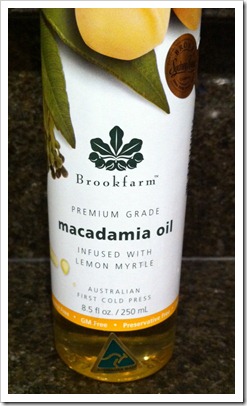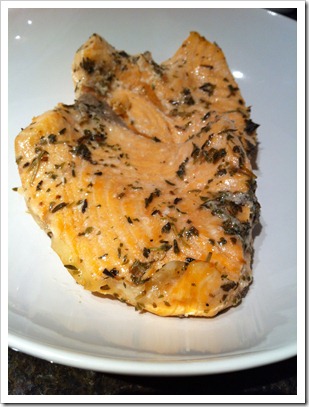Colorful Cauliflower
 I grew up believing that broccoli was just the name for green cauliflower. I now know better, but it turns out that my childhood associations weren’t too far from the truth! Among the various types of cauliflower, there is actually a green variety that looks kind of like broccoli and even has a name similar to broccoli – broccoflower.
I grew up believing that broccoli was just the name for green cauliflower. I now know better, but it turns out that my childhood associations weren’t too far from the truth! Among the various types of cauliflower, there is actually a green variety that looks kind of like broccoli and even has a name similar to broccoli – broccoflower.
Why Cauliflower?
You’re probably wondering why I’ve dedicated a whole post to a simple large ball-like vegetable. The fact is that vegetables are a key part of a low carb diet, and cauliflower is a useful vegetable to know about. When you puree boiled cauliflower, it forms a thick creamy texture that’s great as a thickening agent for soups and sauces. You can also use the puree by itself to make mashed cauliflower (if you add some butter) or cauliflower soup (if you add some chicken broth). In many cases, cauliflower can easily take the place of potatoes in recipes. Additionally, if you throw cauliflower into the food processor, then it forms small grain-like balls that are great for creating faux rice dishes (with a consistency much like couscous). Download the free recipe ebook for mashed cauliflower, cauliflower soup, faux rice, and other recipes. There’s so much that you can cook with just the white cauliflower. But now you can spice up your foods in a new way with all the colorful cauliflowers described below. Just think how cool purple mashed cauliflower will be!
Types of Cauliflower
You probably didn’t know this, but there are a huge number of different cauliflowers (way too many to list). Click here to see the full list. However, one can generally boil it down to 4 different colors of cauliflower:
White: The most common cauliflower is, of course, the white cauliflower that we generally see in the supermarkets. It’s a very nutritious vegetable despite not being green! One cup of cauliflower contains over 75% of your daily recommended amount of vitamin C and over 15% of vitamin K, and studies have even suggested that substances in cauliflower may prevent cancer. Click here to read the news report.
Purple: This rather uncommon cauliflower has such a great color that it’s easy to think it was dyed rather than naturally occurring. Its vibrant color comes from anthocyanin, which is an antioxidant that also causes red cabbages and red onions to be the colors that they are. Some website state that purple cauliflowers are a type of broccoli and that they will turn green when cooked, which can be true (although I haven’t witnessed it yet). Many cauliflower varietals are intermixed with broccoli varietals, and so some purple varietals will turn green when cooked, but other varietals will not. The purple varietal I have pictured above definitely did not turn green when cooked!
Orange: Yes, the colors get even more unusual. The orange cauliflower contains beta-carotene, which is an inactive form of vitamin A, and which is found in other vegetables such as carrots and sweet potatoes. This type of cauliflower was discovered in Canada back in the ‘70s and has since been crossbred with white cauliflowers to create the type that we see today. It has a slightly sweeter and creamier taste than the white variety.
Green: And, finally, we get to broccoflower, which can either be a cauliflower/broccoli hybrid or a mutant type of cauliflower where the white florets produce chlorophyll, which is the same substance that makes other plants green.
Vote Now
Vote for your favorite type of cauliflower below.
What is the Paleo Diet?
 I was recently surprised to find that some of my friends who are generally health-conscious had never heard of the Paleo diet. “It’s sometimes called the ‘caveman diet’?” I replied in a questioning tone. Still no signs of recognition.
I was recently surprised to find that some of my friends who are generally health-conscious had never heard of the Paleo diet. “It’s sometimes called the ‘caveman diet’?” I replied in a questioning tone. Still no signs of recognition.
I spend a lot of time reading and writing about nutrition and diet, so it shouldn’t be surprising that my friends have not heard of certain diets with which I feel intimately acquainted. I guess my friend never read any of the articles entitled “Top 10 Craziest Diets!” (Several of which list and mock the Paleo diet, often alongside diets involving tapeworms – Yes, a tapeworm diet existed back in the 1920s – No, you should not try it)! With a nod to my friend, here is a simple explanation of the Paleo diet.
The basic idea
The Paleo diet is based on the idea that it is, in many ways, healthy to live like our ancestors millions of years ago. The DNA that defines how our bodies function evolves very slowly over a very long time. For instance, humans have really only been eating grains for the past 10,000 or so years, which is too short of a time for our DNA to have evolved to digest those foods properly (likewise, humans have only been eating refined sugars and carbohydrates for an incredibly short time). The fact, then, that modern diets are often very high in grains and refined carbohydrates leads to a variety of health problems (e.g., there have been links to diabetes, allergies, digestion disorders, and Alzheimer’s).
Although it’s often referred to as a diet, Paleo is really more of a lifestyle than a crash course for losing weight (even though weight loss often occurs when eating a Paleo diet). Therefore, it’s not just nutrition that is emphasized, but also exercise and reductions in daily stress. In general, the idea is that our food intake and weekly exercise regimes should more closely mimic that of our prehistoric ancestors. Below is a quick guide to what to eat and what to avoid as well as a description of the types of exercises done on Paleo.
What to eat and what not to eat
Ask yourself what a caveman would have eaten and you’re pretty much there! Click here for some sample meal plans.
- Vegetables are good and should be the bulk of what you eat every day.
- Meat should be consumed plentifully, although pasture-raised or grass-fed meats are encouraged.
- Good fats are highly emphasized in the diet. Good fats include animal fats (including both lard and butter), coconut oil, olive oil, macadamia oil, and avocado oil. These oils are lower in certain fatty acids that most modern diets over-emphasize.
- Some starchy/sugary foods are permitted, although in moderation. For instance, sweet potatoes and yams are both OK to eat, but they should be eaten sparsely.
- Nuts and fruits are allowed, but again only in moderation. Cavemen obviously didn’t have orchards, but they might very occasionally come across some berries and nuts.
- No grains (including oatmeal, rice, whole grains, rye, corn, cous cous, and especially wheat).
- No legumes (including kidney beans, soy beans, black eyed peas, and pinto beans).
- No processed sugars (i.e. – no added sugar in any products you buy or cook).
- Generally, no dairy products (other than butter and heavy cream).
Exercise Regime
There is great emphasis on exercise as cavemen did not sit around all day long. Neither did they jog ten miles a day on hard concrete, though. In addition to actual exercise regimes, Paleo lifestyles tend to encourage just moving around as much as possible (e.g. – walking or biking places and generally not sitting as much as possible).
Cavemen also had to engage in really intense exercise every couple days, since they had to run from predators and/or chase down and kill animals to eat. Recently, an exercise regime referred to as “Crossfit” has gained a lot of popularity among those living a Paleo lifestyle. Many crossfit gyms have sprung up in recent years to offer these regimes. The regimes often include sprinting and weight lifting in short sessions lasting maybe just 20 minutes twice a week! The workout sessions are very short but also very intense. Click here for a video of crossfit exercises.
Creative Cooking
 Following recipes is all very good when you have time to go shopping for ingredients and essential cooking equipment. What about when you’re hungry and just want something to eat without the hassle of going to the grocery store? Or what about when you’re moving apartments (like I did last week) and want to use up all the random foods in the fridge and cupboards? That’s when Creative Cooking comes into play!
Following recipes is all very good when you have time to go shopping for ingredients and essential cooking equipment. What about when you’re hungry and just want something to eat without the hassle of going to the grocery store? Or what about when you’re moving apartments (like I did last week) and want to use up all the random foods in the fridge and cupboards? That’s when Creative Cooking comes into play!
First, look for the main ingredients (some type of meat and/or vegetable).
First, look for the main ingredients (some type of meat and/or vegetable). I found 3 frozen salmon filets in my freezer and a can of bamboo shoots in water (which is fairly low in carbs) in my cupboard.
Second, see what kind of spices and oils (or herbs) you have to flavor the food.
Second, see what kind of spices and oils (or herbs) you have to flavor the food. I luckily hadn’t packed most of my spices and some cooking oils.
Third, determine what cooking equipment you have
Third, determine what cooking equipment you have e.g., pots, pans, oven, grill, etc. I had the oven and microwave (since they were part of the apartment) and some pots and pans.
Fourth, pick a recipe that you have most of the ingredients for – think of how to substitute for the missing ingredients if they are important
Fourth, pick a recipe that you have most of the ingredients for – think of how to substitute for the missing ingredients if they are important (i.e., ingredients that really flavor the dish). I wanted to make my salmon bake recipe, but I had no olive oil, no lemon juice, and no fresh parsley, which are 3 ingredients that really flavor the salmon. So I had to figure out some substitutes for them. I realized after a quick glance through my collection of oils that I had bought from Amazon a bottle of lemon infused macadamia oil (pictured below) a while back and never used it. This was a perfect replacement for both the olive oil and the lemon juice! And then I replaced the fresh parsley with some dried rosemary and thyme. I felt fairly confident that this would turn out ok since the recipe was pretty simple and the substitutions weren’t too crazy.
Then, I had to decide what to do with the bamboo shoots. I had never cooked bamboo shoots before and had bought the 14.8 oz can of bamboo on a whim, but I remembered eating them in Chinese restaurants with chili oil (usually as a cold appetizer). So I figured that chili and bamboo shoots went well together. I therefore decided to stir fry the bamboo shoots with some red chili flakes and hot sauce (since I had no chili sauce) and then added some minced garlic, , salt, and a touch of soy sauce for extra flavor. I was a bit apprehensive about how it would turn out, but it was delicious.
I was lucky that both dishes I made up turned out well; sometimes, it ends up being a disgusting mess. But, it’s fun to be creative, especially when it turns out well! Let me know if you’ve created any good or bad dishes recently by leaving a comment below.



